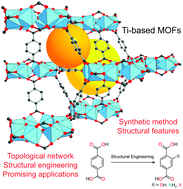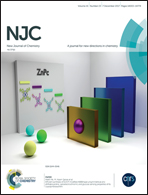The chemistry of titanium-based metal–organic frameworks
Abstract
Due to the many potential applications of metal–organic frameworks (MOFs), research focusing on the design, syntheses, and surface modifications of the new generation of crystalline-based MOF materials has recently received much attention. Among these materials, MOFs based on Ti–oxo clusters are potential candidates for practical applications such as photocatalysis, CO2 reduction, and pollutant degradation because of their high optical responsitivities and photoredox properties. The capabilities of Ti-MOFs in a wide range of applications are inspiring their use as a replacement for TiO2, which has recently been classified as a potential carcinogen. However, the number of tianium–organic framework structures is very limited compared to the many structures of other MOFs. In order to emphasize the importance of discovering new Ti-MOF materials and their related features, this work aims to describe the chemistry of titanium-based MOFs, including their synthetic methods, crystal structures, and topological analysis, as well as further key novel applications, which are desirable for extension to many industrial fields.

- This article is part of the themed collection: 2017 Focus and Perspective articles


 Please wait while we load your content...
Please wait while we load your content...